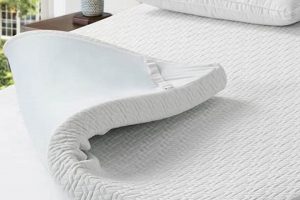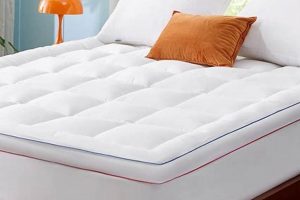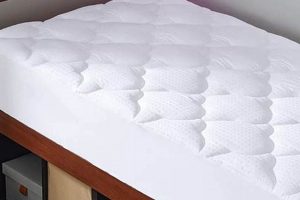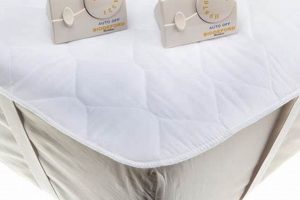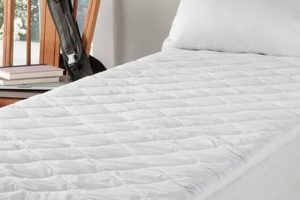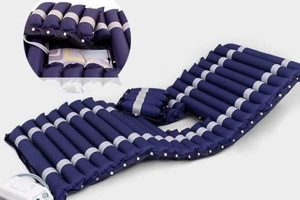This sleep surface accessory serves as a protective layer, designed to shield a mattress from liquids and potential stains. It typically features a waterproof membrane laminated to a fabric top layer, offering a barrier against spills, sweat, and other forms of moisture. These pads are often fitted with elasticized edges or straps to secure them to the mattress, ensuring they remain in place during sleep.
The primary benefit of such protection is the extension of the mattress’s lifespan. By preventing liquids from penetrating the core of the mattress, it safeguards against mold, mildew, and bacterial growth, which can compromise hygiene and structural integrity. These pads also offer allergy protection by creating a barrier against dust mites and other allergens that commonly reside within mattresses. Historically, simpler versions of mattress protectors have been used for centuries, evolving from basic fabric covers to technologically advanced waterproof and breathable materials.
The subsequent sections will delve into the specific features, materials, care instructions, and purchasing considerations related to high-quality mattress protection, examining the factors that contribute to a comfortable and hygienic sleep environment.
Maximizing the Performance and Longevity of Mattress Protection
This section provides essential guidance on utilizing and maintaining a waterproof mattress pad to ensure optimal mattress protection and extend its lifespan.
Tip 1: Prioritize Proper Sizing. Precise fit is crucial for effective protection and comfort. Select a pad that corresponds exactly to the dimensions of the mattress. Overly large pads can bunch up, reducing comfort and protection, while too-small pads leave portions of the mattress exposed.
Tip 2: Adhere to Manufacturer Washing Instructions. Improper cleaning can compromise the waterproof membrane. Always consult and follow the manufacturers guidelines regarding water temperature, detergent type, and drying methods. Avoid using harsh chemicals or bleach, as these can damage the protective layer.
Tip 3: Consider Breathability. Opt for a pad constructed with breathable materials. While waterproof, some pads can trap heat and moisture, leading to discomfort. Breathable fabrics, such as cotton or specific synthetic blends, allow for better air circulation, promoting a cooler and drier sleep environment.
Tip 4: Regularly Inspect for Wear and Tear. Periodic examination for rips, tears, or delamination is essential. Even small imperfections can compromise the waterproof barrier, rendering the pad ineffective. Replace the pad immediately if any damage is detected.
Tip 5: Use in Conjunction with a Mattress Encasement. For comprehensive protection, consider pairing the pad with a full mattress encasement. Encasements provide a 360-degree barrier against bed bugs, allergens, and dust mites, offering an additional layer of defense beyond simple moisture protection.
Tip 6: Avoid Over-Drying. High heat from a dryer can degrade the waterproof layer. Air drying or using a low-heat setting is recommended to preserve the integrity of the pad’s protective qualities.
Tip 7: Promptly Address Spills. Immediate action is critical in the event of spills. Blot the affected area with a clean, absorbent cloth. Avoid rubbing, which can force liquids further into the pad. Follow up with gentle cleaning according to the manufacturers instructions if necessary.
Following these guidelines will ensure the long-term effectiveness of the waterproof mattress protection, safeguarding the mattress and promoting a cleaner, healthier sleep surface.
The following sections will explore the selection criteria for specific mattress pads, focusing on material composition, construction quality, and warranty considerations.
1. Liquid Barrier Integrity
Liquid Barrier Integrity is paramount to the function of any waterproof mattress pad. It determines the degree to which the pad can effectively shield the mattress from liquids, thereby preventing stains, odors, and potential damage that can compromise the mattress’s hygiene and longevity. This protection is crucial, especially in environments where spills or accidents are likely.
- Membrane Material and Construction
The type of waterproof membrane utilized significantly impacts integrity. Polyurethane films are commonly employed for their water resistance and flexibility. The manufacturing process, including lamination techniques, determines how well the membrane adheres to the top fabric layer. Poor lamination can result in separation or pinholes, compromising the barrier. For example, some pads use a heat-sealed membrane to prevent leakage through seams, enhancing overall protection.
- Seam Sealing Techniques
Seams represent a vulnerable point in the waterproof barrier. Effective seam sealing is essential to prevent liquid penetration. Techniques such as taping, welding, or specialized stitching with waterproof thread are employed. Inadequate seam sealing can lead to liquid seepage, particularly around the edges of the pad. High-quality pads undergo rigorous testing to ensure seam integrity under pressure.
- Resistance to Degradation
The liquid barrier must maintain its integrity over time and through repeated use and washing. Some materials may degrade with exposure to detergents, heat, or physical stress. Pads designed for durability often utilize materials resistant to these factors. Regular washing and drying, according to manufacturer instructions, is essential to maintain the barrier’s effectiveness. The ability to withstand multiple wash cycles without compromising the waterproof layer is an important indicator of quality.
- Testing and Certification Standards
Independent testing and certification provide assurance of the liquid barrier’s performance. Standards such as those established by organizations specializing in textile testing assess water resistance, hydrostatic pressure, and permeability. Pads that meet or exceed these standards offer greater confidence in their protective capabilities. Certifications also verify that the materials used are free from harmful substances, ensuring safety and compliance with regulations.
These facets of Liquid Barrier Integrity collectively determine the effectiveness of a waterproof mattress pad. Investing in a product with robust membrane construction, secure seam sealing, resistance to degradation, and verified certification is essential to safeguarding the mattress and ensuring a clean and healthy sleep environment. The overall performance hinges on a holistic approach to design and manufacturing, where each component contributes to the ultimate goal of reliable liquid protection.
2. Material Breathability
Material breathability in a waterproof mattress pad serves as a critical determinant of sleep comfort and overall functionality. While the primary objective of such a pad is to protect the mattress from liquid intrusion, a lack of breathability can create a sleep environment characterized by increased heat and moisture retention. This, in turn, can lead to discomfort, disrupted sleep patterns, and a potential breeding ground for bacteria and mold. The cause-and-effect relationship is direct: impermeable materials trap body heat and perspiration, leading to elevated skin temperature and a damp sleep surface. Breathability, therefore, is not merely an ancillary feature but an essential component that balances protective function with user well-being.
The selection of breathable materials directly impacts the practical efficacy of the mattress pad. For instance, a pad employing a polyurethane membrane without corresponding breathable top layers will likely retain heat, negating some of the hygienic benefits gained from its waterproof nature. Conversely, pads that integrate cotton, bamboo, or specialized synthetic blends with moisture-wicking properties enhance air circulation, mitigating heat buildup. A real-world example is the use of TPU (thermoplastic polyurethane) membranes, which offer a balance of waterproofing and breathability compared to traditional PVC. Such materials allow water vapor to escape, promoting a drier and more comfortable sleep experience. The practical significance lies in the user’s ability to maintain a stable body temperature throughout the night, contributing to deeper and more restorative sleep.
In summary, material breathability in a waterproof mattress pad is inseparable from its overall utility. The challenge lies in achieving an optimal balance between impermeable protection and adequate air circulation. This balance is addressed through careful material selection, innovative construction techniques, and a thorough understanding of the microclimate within the sleep environment. Failing to consider breathability compromises the very benefits the pad aims to deliver, undermining sleep quality and potentially creating unintended hygienic issues. The broader theme underscores the importance of holistic design, where each feature works in concert to create a healthy and comfortable sleep environment.
3. Secure Mattress Fit
The effectiveness of a waterproof mattress pad is inextricably linked to its ability to maintain a secure and consistent fit on the mattress. A poorly fitted pad, regardless of its waterproof capabilities, compromises its protective function. Slippage, bunching, or inadequate coverage expose portions of the mattress to potential spills and stains, rendering the waterproof barrier incomplete. The causal relationship is clear: a lack of secure fit directly diminishes the pad’s primary purpose of safeguarding the mattress.
Secure fit is not merely a matter of aesthetics; it is a functional imperative. A pad that shifts during sleep can create discomfort and disrupt sleep patterns. Furthermore, constant movement can lead to premature wear and tear on both the pad and the mattress itself. The design of the pad plays a crucial role in achieving a secure fit. Elasticized edges, deep pockets, and anchor bands are common features intended to grip the mattress firmly. For example, some pads utilize a “skirt” design with elastic that wraps around the entire mattress, similar to a fitted sheet, providing a more secure hold compared to pads with only corner straps. The practical significance lies in the assurance that the entire sleep surface remains protected throughout the night, regardless of movement.
In essence, secure mattress fit is a foundational element of a high-quality waterproof mattress pad. It ensures complete and consistent protection, enhances sleep comfort, and prolongs the lifespan of both the pad and the underlying mattress. The challenge lies in selecting a pad with a design that accommodates various mattress depths and profiles while maintaining a snug and reliable fit. By prioritizing secure fit, consumers can maximize the benefits of their waterproof mattress pad and maintain a clean and hygienic sleep environment. The overarching theme reinforces the need for a holistic approach to mattress protection, where fit, function, and material quality are all carefully considered.
4. Durability and Lifespan
The durability and lifespan of a waterproof mattress pad are critical factors influencing its overall value and effectiveness in protecting the underlying mattress. The pad’s primary function is to shield the mattress from liquids, allergens, and wear, thus extending the mattress’s usable life. Consequently, a pad that degrades quickly necessitates frequent replacement, negating its intended cost-saving benefit and potentially exposing the mattress to damage during periods of inadequate protection. The relationship is fundamentally causal: reduced durability leads directly to a shorter lifespan and compromised mattress protection.
Material selection and construction techniques significantly impact durability. High-quality pads typically utilize durable, tightly woven fabrics and robust waterproof membranes that can withstand repeated washing and normal wear. Reinforcements at stress points, such as elasticized edges or seams, further enhance longevity. For instance, a pad employing a multi-layered construction with a tear-resistant top fabric, a waterproof but breathable membrane, and reinforced seams would demonstrably outlast a pad made with thinner, less durable materials. Moreover, adherence to recommended care instructions is crucial; improper washing or drying can accelerate degradation and shorten the pad’s lifespan. Regular inspection for signs of wear, such as thinning fabric or compromised seams, allows for timely replacement, preventing potential damage to the mattress.
In summary, durability and lifespan are essential components of a waterproof mattress pad, directly affecting its protective capabilities and long-term value. Selecting a pad constructed from high-quality materials, employing robust construction techniques, and adhering to proper care guidelines maximizes its lifespan and ensures consistent mattress protection. The challenge lies in balancing cost considerations with the need for durable, long-lasting performance. Prioritizing durability ultimately translates to greater value and sustained protection for the underlying mattress, contributing to a cleaner, healthier sleep environment.
5. Ease of Maintenance
The correlation between ease of maintenance and a waterproof mattress pad is a critical factor in its long-term effectiveness and user satisfaction. A mattress pad, regardless of its protective capabilities, becomes significantly less valuable if its upkeep is overly burdensome or complex. The ease with which the pad can be cleaned and maintained directly affects how consistently it is used and, therefore, its overall contribution to protecting the underlying mattress.
Consider a scenario where a waterproof mattress pad requires specialized cleaning solutions or delicate handling procedures. The increased effort involved in its care
may lead to infrequent washing, potentially allowing stains or allergens to accumulate and compromise the sleep surface’s hygiene. In contrast, a pad that can be readily machine-washed and dried, using standard detergents, promotes regular cleaning and maintenance of a sanitary sleeping environment. Materials that resist staining, such as those with stain-release finishes, also contribute to ease of maintenance by simplifying the cleaning process. Furthermore, construction features that prevent excessive shrinkage or distortion during washing cycles enhance the pad’s lifespan and sustained effectiveness.
In summation, ease of maintenance is an indispensable component of a practical and effective waterproof mattress pad. It facilitates consistent and thorough cleaning, safeguarding the mattress from damage and promoting a healthier sleep environment. The challenge lies in selecting a pad that balances protective features with user-friendly maintenance requirements. Prioritizing ease of care ensures the pad is regularly cleaned, maximizing its protective benefits and providing long-term value to the consumer.
Frequently Asked Questions Regarding Waterproof Mattress Pads
The following addresses common inquiries and misconceptions surrounding waterproof mattress pads, providing clarity on their function, care, and effectiveness.
Question 1: What distinguishes a waterproof mattress pad from a water-resistant pad?
A waterproof mattress pad incorporates an impermeable layer that prevents liquids from penetrating into the mattress. A water-resistant pad offers a degree of protection but may allow liquid penetration under certain conditions, such as prolonged exposure or significant spills.
Question 2: Can a waterproof mattress pad impact the breathability of the mattress?
Some waterproof mattress pads may reduce mattress breathability, potentially leading to increased heat retention. Selecting pads constructed with breathable materials, such as cotton or specialized synthetic blends, can mitigate this effect.
Question 3: How frequently should a waterproof mattress pad be washed?
The washing frequency depends on usage and environmental factors. Generally, washing the pad every one to two months is recommended. Spills or accidents necessitate immediate cleaning.
Question 4: Will a waterproof mattress pad eliminate the need for a mattress protector?
The terms are often used interchangeably. A waterproof mattress pad functions as a protector. However, for comprehensive protection against bed bugs and allergens, consider a full mattress encasement in addition to the waterproof pad.
Question 5: Can a waterproof mattress pad be used with memory foam mattresses?
Yes, waterproof mattress pads are compatible with memory foam mattresses. Ensure the pad is breathable to prevent excessive heat build-up, a common concern with memory foam.
Question 6: How can the lifespan of a waterproof mattress pad be maximized?
Following manufacturer’s care instructions is crucial. Avoid harsh chemicals or high heat during washing and drying. Promptly address spills and inspect the pad regularly for wear and tear.
In conclusion, waterproof mattress pads offer essential protection for mattresses. Understanding their features, limitations, and proper care enhances their effectiveness and ensures a cleaner, healthier sleep environment.
The following section will explore purchasing considerations for selecting a waterproof mattress pad.
Conclusion
This exploration has underscored the vital role of a waterproof mattress pad in safeguarding a significant investment. It has detailed the multifaceted features influencing its efficacy, encompassing liquid barrier integrity, material breathability, secure fit, durability, and ease of maintenance. These elements, when optimized, contribute to a hygienic and comfortable sleep environment, extending the lifespan of the underlying mattress. However, compromise in any of these areas can negate the intended protective benefits.
Therefore, careful consideration of these factors is paramount in the selection process. The optimal choice ensures a balance between cost, performance, and longevity. The investment in a high-quality, well-maintained waterproof mattress pad represents a proactive measure in preserving sleep quality and protecting a valuable asset.


